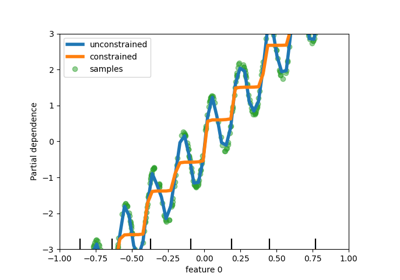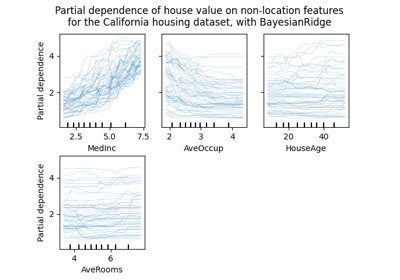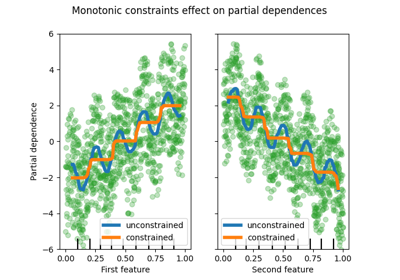备注
Go to the end 下载完整的示例代码。或者通过浏览器中的MysterLite或Binder运行此示例
scikit-learn 0.23的发布亮点#
我们很高兴宣布scikit-learn 0.23的发布!添加了许多错误修复和改进,以及一些新的关键功能。我们在下面详细介绍了该版本的一些主要功能。 For an exhaustive list of all the changes ,请参阅 release notes .
安装最新版本(使用pip):
pip install --upgrade scikit-learn
或带有conda::
conda install -c conda-forge scikit-learn
广义线性模型和梯度增强的Poisson损失#
期待已久的具有非正态损失函数的广义线性模型现已推出。特别是,实施了三个新的回归器: PoissonRegressor , GammaRegressor ,而且 TweedieRegressor . Poisson回归量可用于建模正整数或相对频率。阅读更多的 User Guide .此外, HistGradientBoostingRegressor 也支持新的“poisson”损失。
import numpy as np
from sklearn.ensemble import HistGradientBoostingRegressor
from sklearn.linear_model import PoissonRegressor
from sklearn.model_selection import train_test_split
n_samples, n_features = 1000, 20
rng = np.random.RandomState(0)
X = rng.randn(n_samples, n_features)
# positive integer target correlated with X[:, 5] with many zeros:
y = rng.poisson(lam=np.exp(X[:, 5]) / 2)
X_train, X_test, y_train, y_test = train_test_split(X, y, random_state=rng)
glm = PoissonRegressor()
gbdt = HistGradientBoostingRegressor(loss="poisson", learning_rate=0.01)
glm.fit(X_train, y_train)
gbdt.fit(X_train, y_train)
print(glm.score(X_test, y_test))
print(gbdt.score(X_test, y_test))
0.35776189065725783
0.42425183539869415
估计量的丰富视觉表示#
现在,通过启用 display='diagram' 选项.这对于总结管道和其他复合估计器的结构特别有用,并具有交互性以提供详细信息。 单击下面的示例图像以展开Pipeline元素。 看到 可视化复合估计器 了解如何使用此功能。
from sklearn import set_config
from sklearn.compose import make_column_transformer
from sklearn.impute import SimpleImputer
from sklearn.linear_model import LogisticRegression
from sklearn.pipeline import make_pipeline
from sklearn.preprocessing import OneHotEncoder, StandardScaler
set_config(display="diagram")
num_proc = make_pipeline(SimpleImputer(strategy="median"), StandardScaler())
cat_proc = make_pipeline(
SimpleImputer(strategy="constant", fill_value="missing"),
OneHotEncoder(handle_unknown="ignore"),
)
preprocessor = make_column_transformer(
(num_proc, ("feat1", "feat3")), (cat_proc, ("feat0", "feat2"))
)
clf = make_pipeline(preprocessor, LogisticRegression())
clf
KMeans的可扩展性和稳定性改进#
的 KMeans 估计器完全重新设计,现在它明显更快、更稳定。此外,Elkan算法现在与稀疏矩阵兼容。估计器使用基于BEP的并行性,而不是依赖于jobib,因此 n_jobs 参数不再起作用。有关如何控制线程数的更多详细信息,请参阅我们的 并行性 notes.
import numpy as np
import scipy
from sklearn.cluster import KMeans
from sklearn.datasets import make_blobs
from sklearn.metrics import completeness_score
from sklearn.model_selection import train_test_split
rng = np.random.RandomState(0)
X, y = make_blobs(random_state=rng)
X = scipy.sparse.csr_matrix(X)
X_train, X_test, _, y_test = train_test_split(X, y, random_state=rng)
kmeans = KMeans(n_init="auto").fit(X_train)
print(completeness_score(kmeans.predict(X_test), y_test))
0.6585602198584782
基于柱状图的梯度增强估计器的改进#
进行了各种改进, HistGradientBoostingClassifier 和 HistGradientBoostingRegressor .在上面提到的泊松损失之上,这些估计量现在支持 sample weights .此外,还增加了自动提前停止条件:样本数量超过10k时默认启用提前停止。最后,用户现在可以定义 monotonic constraints 根据特定特征的变化来约束预测。在下面的例子中,我们构建了一个通常与第一个特征正相关的目标,并带有一些噪音。应用单元约束允许预测捕捉第一个特征的全局效应,而不是适应噪音。有关用例示例,请参阅 梯度增强树的梯度中的功能 .
import numpy as np
from matplotlib import pyplot as plt
from sklearn.ensemble import HistGradientBoostingRegressor
# from sklearn.inspection import plot_partial_dependence
from sklearn.inspection import PartialDependenceDisplay
from sklearn.model_selection import train_test_split
n_samples = 500
rng = np.random.RandomState(0)
X = rng.randn(n_samples, 2)
noise = rng.normal(loc=0.0, scale=0.01, size=n_samples)
y = 5 * X[:, 0] + np.sin(10 * np.pi * X[:, 0]) - noise
gbdt_no_cst = HistGradientBoostingRegressor().fit(X, y)
gbdt_cst = HistGradientBoostingRegressor(monotonic_cst=[1, 0]).fit(X, y)
# plot_partial_dependence has been removed in version 1.2. From 1.2, use
# PartialDependenceDisplay instead.
# disp = plot_partial_dependence(
disp = PartialDependenceDisplay.from_estimator(
gbdt_no_cst,
X,
features=[0],
feature_names=["feature 0"],
line_kw={"linewidth": 4, "label": "unconstrained", "color": "tab:blue"},
)
# plot_partial_dependence(
PartialDependenceDisplay.from_estimator(
gbdt_cst,
X,
features=[0],
line_kw={"linewidth": 4, "label": "constrained", "color": "tab:orange"},
ax=disp.axes_,
)
disp.axes_[0, 0].plot(
X[:, 0], y, "o", alpha=0.5, zorder=-1, label="samples", color="tab:green"
)
disp.axes_[0, 0].set_ylim(-3, 3)
disp.axes_[0, 0].set_xlim(-1, 1)
plt.legend()
plt.show()

支持Lasso和ElasticNet的样本权重#
两个线性回归量 Lasso 和 ElasticNet 现在支持样本权重。
import numpy as np
from sklearn.datasets import make_regression
from sklearn.linear_model import Lasso
from sklearn.model_selection import train_test_split
n_samples, n_features = 1000, 20
rng = np.random.RandomState(0)
X, y = make_regression(n_samples, n_features, random_state=rng)
sample_weight = rng.rand(n_samples)
X_train, X_test, y_train, y_test, sw_train, sw_test = train_test_split(
X, y, sample_weight, random_state=rng
)
reg = Lasso()
reg.fit(X_train, y_train, sample_weight=sw_train)
print(reg.score(X_test, y_test, sw_test))
0.999791942438998
Total running time of the script: (0分0.442秒)
相关实例
Gallery generated by Sphinx-Gallery <https://sphinx-gallery.github.io> _




